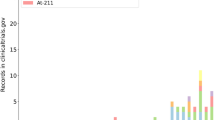Abstract.
Whole-body fluorine-18 fluoro-2-d-deoxyglucose positron emission tomography (FDG-PET) is widely used in clinical centres for diagnosis, staging and therapy monitoring in oncology. Images are usually not corrected for attenuation since filtered backprojection (FBP) reconstruction methods require a 10 to 15-min transmission scan per bed position on most current PET devices equipped with germanium-68 rod transmission sources. Such an acquisition protocol would increase the total scanning time beyond acceptable limits. The aim of this work is to validate the use of iterative reconstruction methods, on both transmission and emission scans, in order to obtain a fully corrected whole-body study within a reasonable scanning time of 60 min. Five minute emission and 3-min transmission scans are acquired at each of the seven bed positions. The transmission data are reconstructed with OSEM (ordered subsets expectation maximization) and the last iteration is reprojected to obtain consistent attenuation correction factors (ACFs). The emission image is then also reconstructed with OSEM, using the emission scan corrected for normalization, scatter and decay together with the set of consistent ACFs as inputs. The total processing time is about 35 min, which is acceptable in a clinical environment. The image quality, readability and accuracy of uptake quantification were assessed in 38 patients scanned for various malignancies. The sensitivity for tumour detection was the same for the non-attenuation-corrected (NAC-FBP) and the attenuation-corrected (AC-OSEM) images. The AC-OSEM images were less noisy and easier to interpret. The interobserver reproducibility was significantly increased when compared with non-corrected images (96.1% vs 81.1%, P<0.01). Standardized uptake values (SUVs) measured on images reconstructed with OSEM (AC-OSEM) and filtered backprojection (AC-FBP) were similar in all body regions except in the pelvic area, where SUVs were higher on AC-FBP images (mean increase 7.74%, P<0.01). Our results show that, when statistical reconstruction is applied to both transmission and emission data, high quality quantitative whole-body images are obtained within a reasonable scanning (60 min) and processing time, making it applicable in clinical practice.
Similar content being viewed by others
Author information
Authors and Affiliations
Additional information
Received 27 November 1998 and in revised form 31 January 1999
Rights and permissions
About this article
Cite this article
Lonneux, M., Borbath, I., Bol, A. et al. Attenuation correction in whole-body FDG oncological studies: the role of statistical reconstruction. Eur J Nucl Med 26, 591–598 (1999). https://doi.org/10.1007/s002590050426
Issue Date:
DOI: https://doi.org/10.1007/s002590050426




